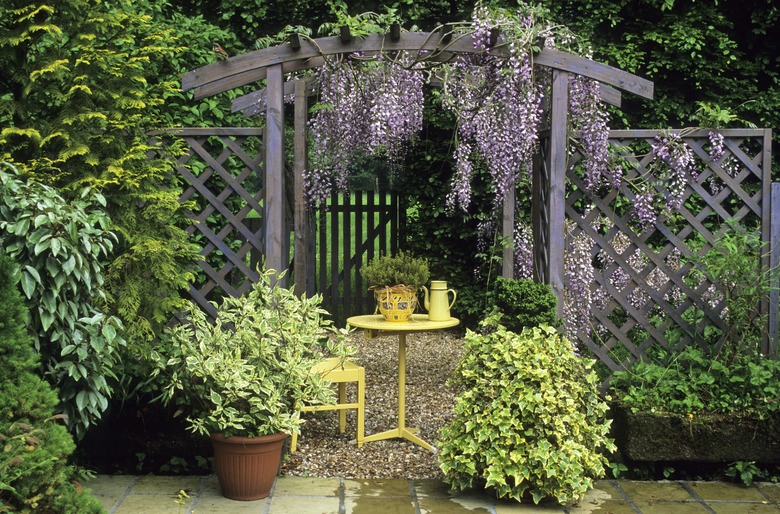How Often Does Wisteria Bloom?
We may receive a commission on purchases made from links.
The wisteria vine drapes its fragrant, lilac-colored blossoms across trees and structures in mid to late spring depending on the species. Typically, blooms will grace the vine for three weeks up to two months and only appear once a year. However, special wisteria cultivars are known to bloom two to three times in a season.
Tip
Once your wisteria has been established, it will likely only bloom once a year. However, some cultivars of Kentucky and American wisteria offer two to three blooming periods in a growing season.
When Does Wisteria Bloom?
When Does Wisteria Bloom?
If you've noticed bursts of purple wisteria blossoms showing up across your local trees, then it's a sure sign that spring is in full effect. Identifying the exact month that you can expect to see wisteria blooms will depend on the species of wisteria.
American wisteria (Wisteria frutescens) blooms as early as the beginning of June and on through August. If you happen to have the Amethyst Falls cultivar, then you may be blessed with a second blooming.
Kentucky wisteria (Wisteria macrostachya) shows its purple clusters a bit later in the early summer around the end of June, and the Blue Moon cultivar will bloom up to three times.
The fragrant Japanese wisteria (Wisteria floribunda) and twining Chinese wisteria (Wisteria sinensis) bloom before their American cousins, starting in April. These species grow their flower buds before the foliage.
Why Won’t My Wisteria Bloom?
Why Won't My Wisteria Bloom?
Growing wisteria from seed could take you 15 years to see a bloom. If you have a cutting, don't expect your wisteria to bloom the season after you've planted it. Wisteria takes its sweet time to reward gardeners with blooms, typically two to three years after planting.
However, if your plant is well established and refuses to bloom, make sure that the wisteria is receiving its ideal living conditions. This includes spacing wisteria plants at least 10 feet apart and in a location that receives full sun. Wisteria prefers well-draining soil and weekly watering. American wisteria does well in zones 5 to 9, while Kentucky wisteria thrives in Zones 4 to 9.
How to Prune Wisteria
How to Prune Wisteria
Maybe this season didn't produce many wisteria blooms, but you can set up for a bountiful blooming season next year by pruning twice. Your first prune should be in summer. Removing vine growth in the summer lets sunlight and air reach the youngest growth at the base and helps with flower bud formation. Use clean, sharp gardening shears and cut the new growth's green shoots to six leaves.
The second prune happens in late winter. Wisteria flowers on new wood, so pruning back established growth creates more opportunity for flowering (and a tidier vine). Cut the same shoots that you pruned in the summer down to three buds.
A routine pruning schedule will also help keep this enthusiastic climbing vine from completely taking over your garden, trees, or pergola.
Warnings Regarding Wisteria
Warnings Regarding Wisteria
Wisteria may be beautiful, but it's also dangerous for several reasons. The entire plant is toxic to pets and people if consumed due to lectin and wisterin. Large amounts can even be fatal.
Some states consider Chinese and Japanese wisteria plants to be invasive species. Left unchecked, these plants could choke out all the other plants in your garden and even kill their host trees. Planting wisteria in a container could be an option to keep your other plants and structures safe.
Wisteria is so hardy and formidable that it's known to grow into structures, like cracks in your home. It is not recommended to use your home as the climbing structure for your wisteria plant due to possible structural damage.
